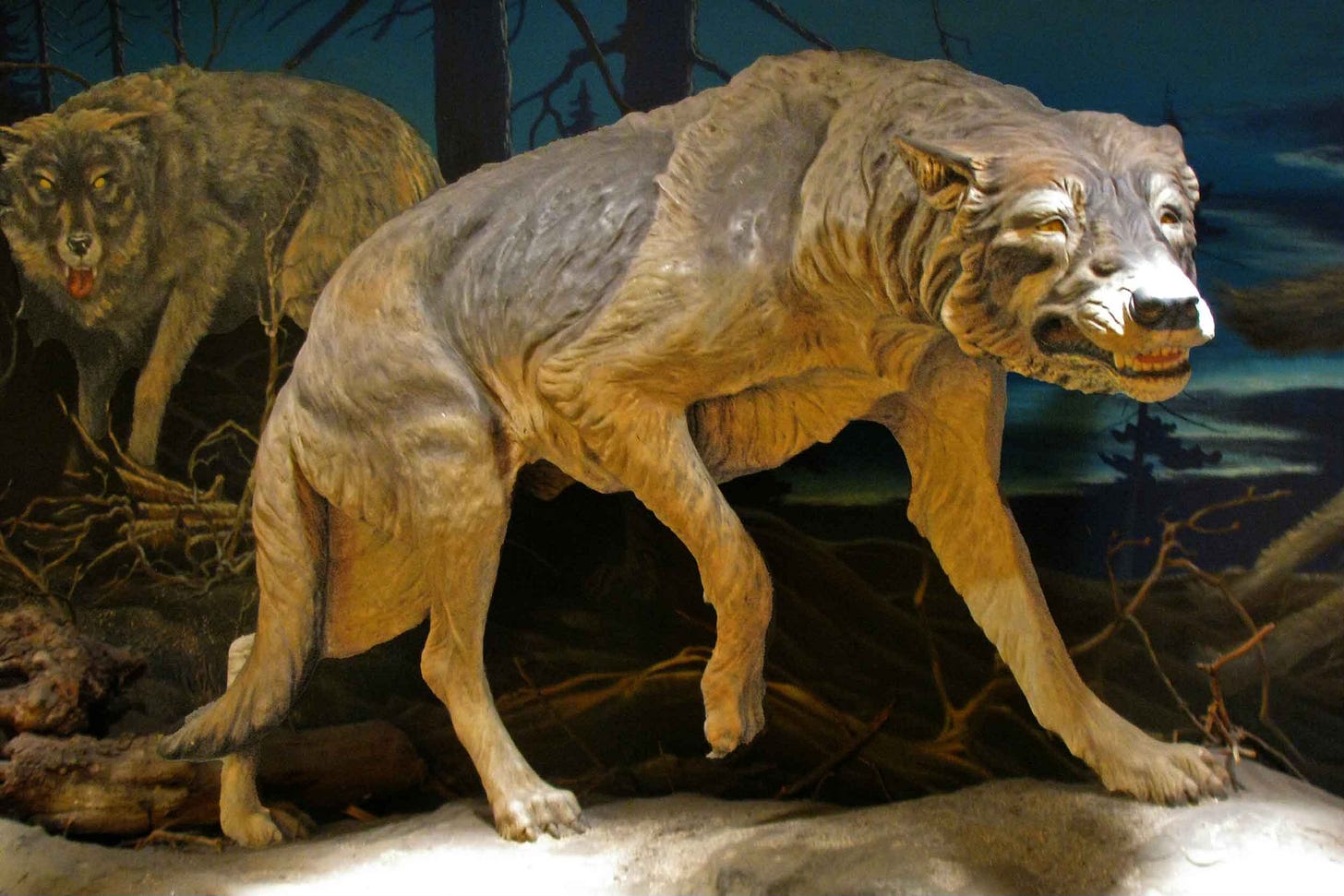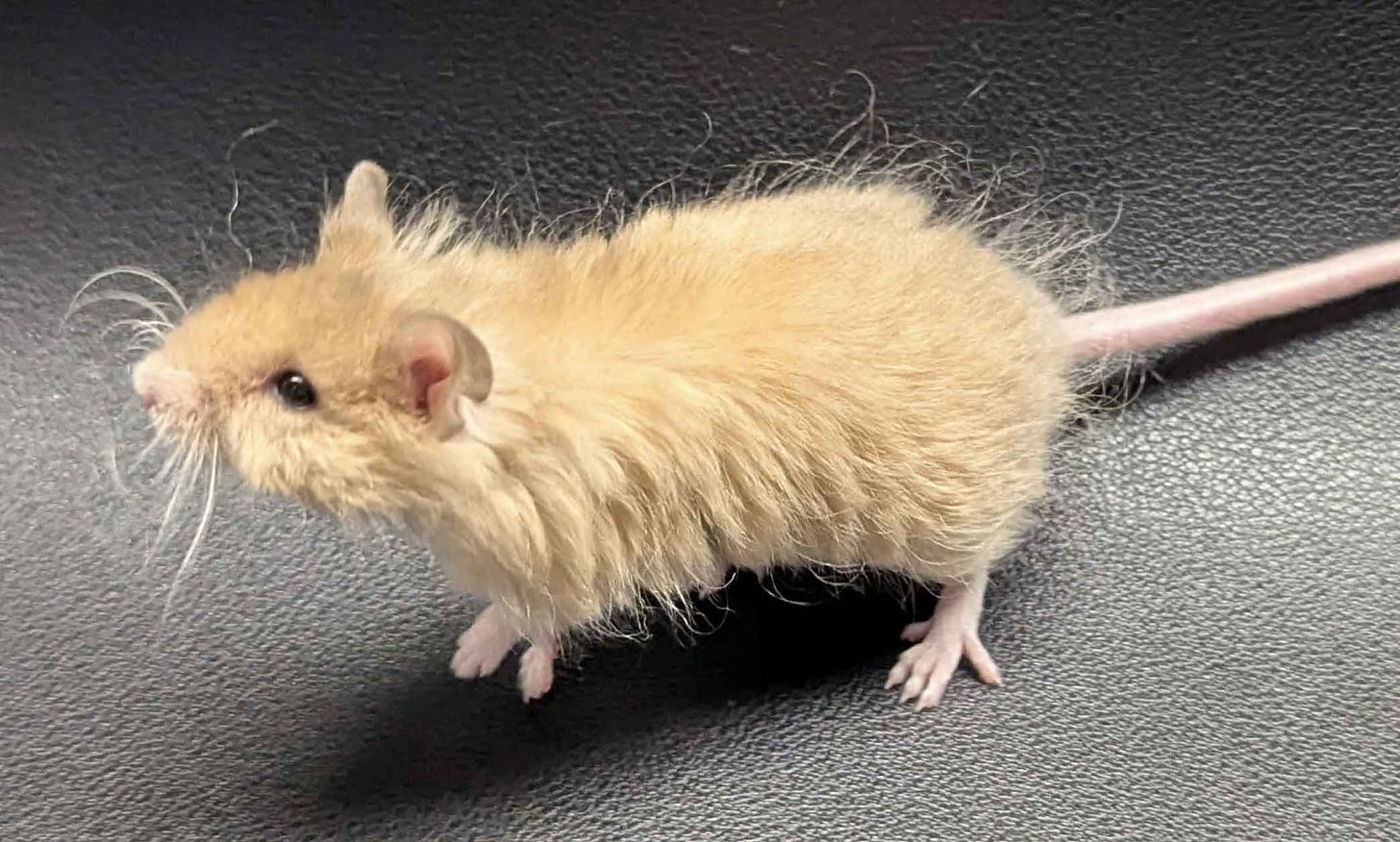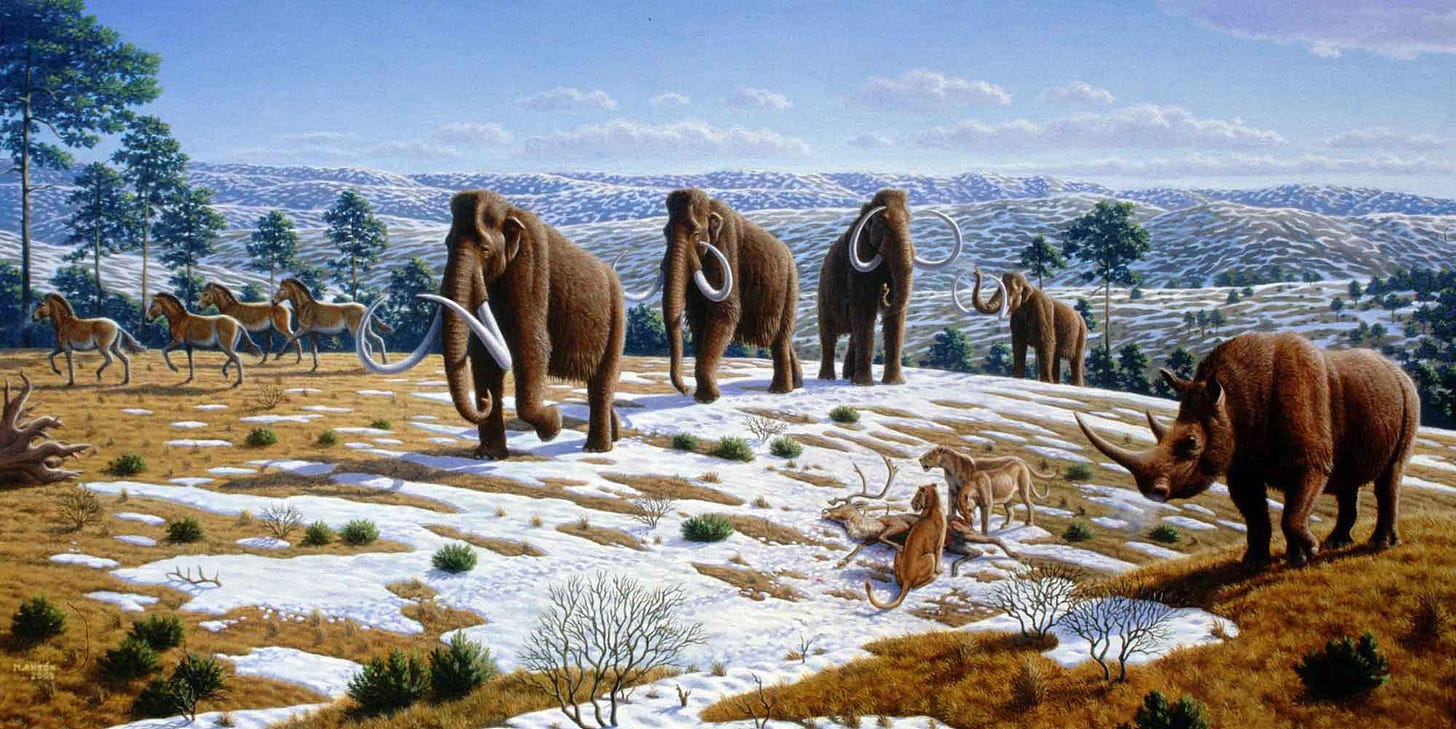Dire wolves are just the beginning
The technologies used to create the multiple gene-edited puppies may show the potential for more familiar species, including humans.

In April, Colossal Biosciences announced that its scientists had recreated the extinct species known as the dire wolf, Canis dirus. Three white puppies—Remus, Romulus, and Khaleesi—were born from a trans-species menage à trois: Each puppy started as a gray wolf embryo, scientists made 20 edits to 14 genes attempting to recreate the appearance of dire wolves, and implanted the embryos into domestic dog surrogate mothers that carried them.
This came a month after the company revealed its “woolly mice” experiment. By editing up to nine genes affecting fur and pigmentation, they produced mice that are fluffy and tan as a tiny stuffed mammoth.
In the past I’ve been very critical of the mammoth de-extinction idea, to put it mildly, and I haven’t entirely changed my tune. Still, I’m thinking about these new developments differently. The public conversation is missing the real story and why it matters in a big way.
Extinct species may be Colossal’s business, but they’re a sideshow. Instead, the impact of these technologies will shape the future of humans and our agricultural ecosystems. Twenty gene edits can’t make a mammoth, but they could enable designed changes to enhance traits for domesticated animals or even children. The frontier of designed evolution through gene editing is pulling rapidly closer.
Fascination and indignation
I’ve been fascinated since the release of the dire wolf and woolly mouse stories at how much public hoopla has surrounded them. It’s one of the very few science stories to penetrate the media world of every student in my course in human genetics. People just cannot get enough of the dire wolves!

Backlash from scientists has been even more intense. Many evolutionary and conservation biologists object that the name “dire wolves” is false advertising. Colossal has not de-extincted anything, they argue. Nobody really knows how many genes it would take to transform an embryo from Canis lupus into Canis dirus, but it’s a lot more than fourteen.
Other scientists object to the de-extinction project as a whole, arguing that it diverts resources and effort away from endangered species that need protection today. Another important issue that receives too little attention is the welfare of animals created for human experimentation.
I made some of these observations myself back in 2017 when I wrote that mammoth cloning is fake news. At that date Colossal Biosciences didn’t yet exist, but one of its founders, the Harvard geneticist George Church, spent much of the 2010s claiming that a baby mammoth might be a mere two years away. That was not realistic in 2017 nor is it realistic now.
Still, at the time I wrote my critical take eight years ago, my biggest irritation was with journalists and media flacks who kept repeating the same tired story without any recognition that it wasn’t coming to pass.
This year the story really has changed. These ongoing experiments show surprisingly strong potential for further progress in gene editing. Not mammoths, but something with potentially greater long-term importance. Folks are right to be interested in these stories, because what’s coming goes well beyond this handful of animals.
Multiplex gene editing
Colossal’s experiments illuminate the ongoing changes in the landscape of genetic modification. Multiplex gene editing of mammals is being applied by many researchers around the world. For example, one group this year created pigs with multiple edits to deactivate genes such as endogenous retroviruses that are barriers to xenotransplantation of organs into humans. Multiplex gene editing of embryos is also being used to create strains of mice that express humanlike disease phenotypes. Some of those changes are gain-of-function, not knockouts. The resulting mice can help researchers to better understand gene interactions and test possible treatments.
For the work from Colossal, few details have been released about the dire wolf experiments, but the mouse experiments are described in a preprint led by Rui Chen. In that work, the team worked with several strategies for editing multiple genes in mouse embryos. Two of the approaches introduced edits into all the cells of early stage zygotes, while other approaches added edited stem cells into later-stage embryos to create chimeras, individuals with some cell lines originating from edited embryonic stem cells. The success rates of all approaches were impressive. By sequencing the genomes of the individuals after birth, the team showed that there had been few unintended genetic changes, known as off-target effects.

The fact that Colossal teams are having success with multiplex gene editing puts them among many other groups. Where the work stands out is in its aims and scope. Instead of laboratory phenotypes, Colossal scientsts are working to approximate traits that once existed in natural populations, affecting biological systems as diverse as hair, body size, pigmentation, and metabolism.
Integrating these areas is a huge challenge, but it’s a challenge that favors exploration of a much wider phenotypic space than most other applications. Discoveries made along the way are likely to be novel.
The most significant fact about the attempts so far is that they’ve worked. To be sure, it’s early to make predictions, but the success so far suggests that fast progress may be achievable.
The company has several active patent applications for innovations related to these gene editing methods. Few details are publicly available about the wolf gene editing experiments, but reporting suggests that more patent applications will be coming.
Leveraging effect sizes
If most traits were influenced by variation in a single gene, it would be easy to figure out how to change traits by editing that gene. But most of a mammal’s physical structure, development, and behavior is affected by many genes, not just one. Human complex traits are often influenced by hundreds of genes, each having a tiny effect on the variation in the population.
How can scientists design changes to such traits?
The trick of maximizing the effect of gene editing is to choose edits that make a big difference to the traits. This takes biological insight.
One strategy is to exploit genetic variants that have a large effect within a family—for example, between siblings—but are so rare that they don’t make much difference across the population as a whole. Just one of these rare large-effect variants edited into a genome might have much more of an effect on a trait than a dozen or more common variants.
Colossal used a mouse-specific version of this strategy for the woolly mice. Decades of mouse genetics have generated a lot of data on rare mutations with interesting effects on pigmentation and hair form. The team drew from this information to choose large-effect edits with a strong chance of generating the desired traits.
A different strategy is to exploit phylogeny. Genetic variants that differ between two sister species have a good chance of large effect sizes without many negative side effects. DNA from an extinct species is thus a time capsule from a natural laboratory.
That’s exactly how many human geneticists are using Neanderthal and Denisovan genomes now to probe human gene-trait relationships. In Colossal’s work with dire wolves, mammoths, and other extinct mammals, the ancient genomes are a very productive route to discovery.
Considering these strategies, Colossal’s scientists are in a very interesting place for designing traits with gene editing. The outcomes for the so-called dire wolves and for the woolly mice may have worked out for exactly these reasons.
Humans and others?
The same strategies will have value for anyone trying to design traits in a mammal by gene editing. Domesticated animals are an obvious application. Dogs, cats, horses, cows, and pigs each have wild relatives, every one a library of gene variants for would-be gene editors to explore.
The same approaches in principle would work for people, too. Just as for the dire wolves and woolly mice, multiplexing twenty large-effect gene edits could enable a lot of trait selection in human children.

Human application of germline editing is not likely to happen soon. The Oviedo Convention, adopted by many countries in Europe, prohibits genetic changes that would affect descendants, and at least 75 countries have similar regulations. Embryonic human gene editing is allowed for in vitro experiments in the U.S. but not for clinical use in assisted reproduction.
Yet that may change. If off-target effects remain low, there will be a lot of interest in applying gene editing in conjunction with in vitro fertilization, just as today people use pre-implantation genetic diagnosis. Demonstrating the safety of such approaches is the big challenge that de-extinction research may help satisfy.
So I think the dire wolves are just the beginning. Similar gene editing is about to become possible for much more familiar species, possibly including ourselves. Scientists who can make a big, fluffy wolf can probably make a taller, more athletic child.
Colossal Biosciences itself is not likely to take up such work directly. The company’s statements and research to date have been focused almost entirely on the de-extinction mission. Still, the company has applied for international patents for inventions related to assisted reproduction and cancer detection, and human applications for the company’s licensed patents are hardly out of the question. A lot of people may be wondering why the company has recently attained a $10.2 billion valuation based on the concept of de-extinction, and the answer is technology applications.
Colossal is far from alone in this space. Some other companies are well advanced in somatic cell gene therapies that do not affect the germline. Others have deep experience in reproductive technologies, where there is already widespread uptake of non-editing approaches like pre-implantation genetic diagnosis.
When it comes to the core mission of Colossal Biosciences, de-extinction, the conditions to recognize success are far from clear. With its statements and information releases, the company is already claiming success. That the bar very low. At the opposite extreme many scientists would insist that even a clone of an ancient animal would not prove it de-extincted. Myself, I’m not yet ready to predict that the company will revive any lost species.
But I’m not betting against them, either.
Notes: I have no investment or consulting role in Colossal Biosciences or any other company that would constitute a conflict of interest for this story.
References
Chen, R., Srirattana, K., Coquelin, M. L., Sampaio, R. V., Wilson, R., Ganji, R., Weston, J., Ledesma, A., Beebe, J., Sullivan, J., Qin, Y., Chao, J. C., Papizan, J., Mastracci, A., Bhide, K., Mathews, J., Oglesby, R., Menon, M., Valk, T. van der, … Abrams, M. E. (2025). Multiplex-edited mice recapitulate woolly mammoth hair phenotypes (p. 2025.03.03.641227). bioRxiv. https://doi.org/10.1101/2025.03.03.641227
Davis, N. (2025, March 4). Scientists aiming to bring back woolly mammoth create woolly mice. The Guardian. https://www.theguardian.com/science/2025/mar/04/genetically-modified-woolly-mice-mammoth
Duan, X., Chen, C., Du, C., Guo, L., Liu, J., Hou, N., Li, P., Qi, X., Gao, F., Du, X., Song, J., & Wu, S. (2025). Homozygous editing of multiple genes for accelerated generation of xenotransplantation pigs. Genome Research, 35(5), 1167–1178. https://doi.org/10.1101/gr.279709.124
Gedman, G. L., Pirovich, K. M., Oppenheimer, J., Hyseni, C., Cassatt-Johnstone, M., Alexandre, N., Troy, W., Chao, C., Fedrigo, O., Hoyt, S. J., Grady, P. G. S., Sacco, S., Seligmann, W., Dash, A., Chokshi, M., Knecht, L., Papizan, J. B., Miyawaki, T., Bocklandt, S., … Shapiro, B. (2025). On the ancestry and evolution of the extinct dire wolf (p. 2025.04.09.647074). bioRxiv. https://doi.org/10.1101/2025.04.09.647074
Hawks, J. (2017, February 19). How mammoth cloning became fake news. Medium. https://medium.johnhawks.net/how-mammoth-cloning-became-fake-news-1e3a80e54d42
Kluger, J. (2025, April 7). The Return of the Dire Wolf. TIME. https://time.com/7274542/colossal-dire-wolf/
Timmer, J. (2025, April 7). De-extinction company announces that the dire wolf is back. Ars Technica. https://arstechnica.com/science/2025/04/de-extinction-company-announces-that-the-dire-wolf-is-back/

